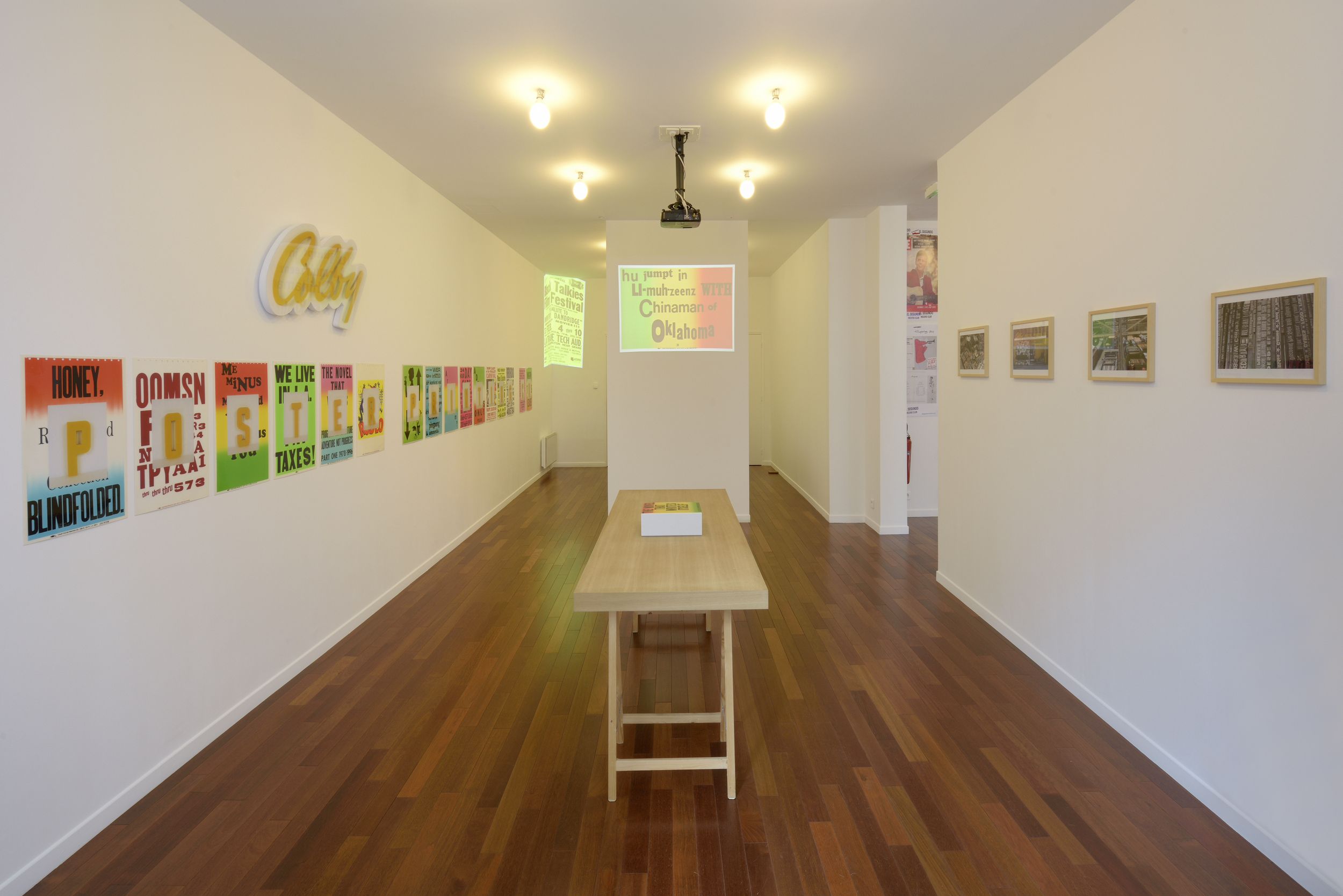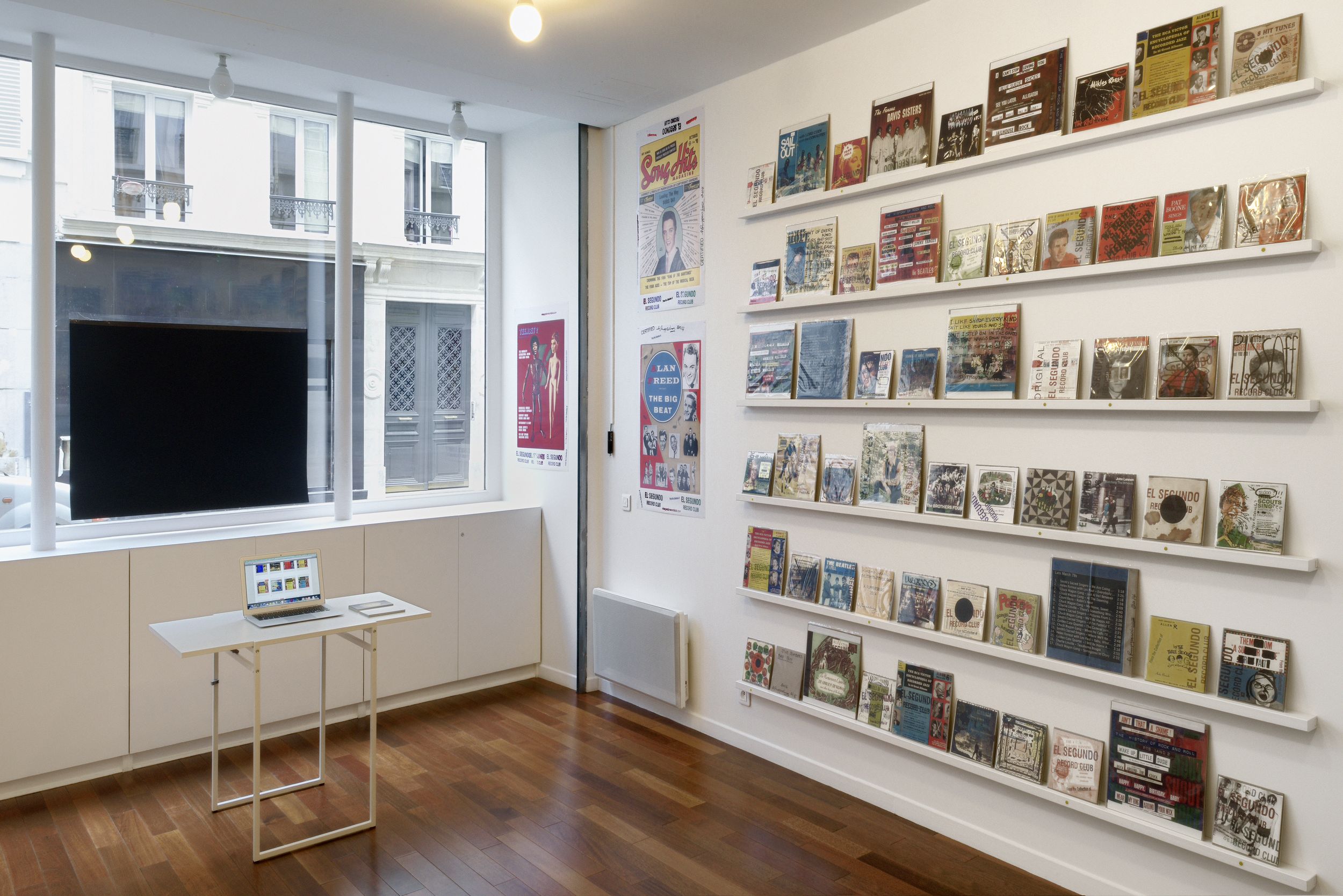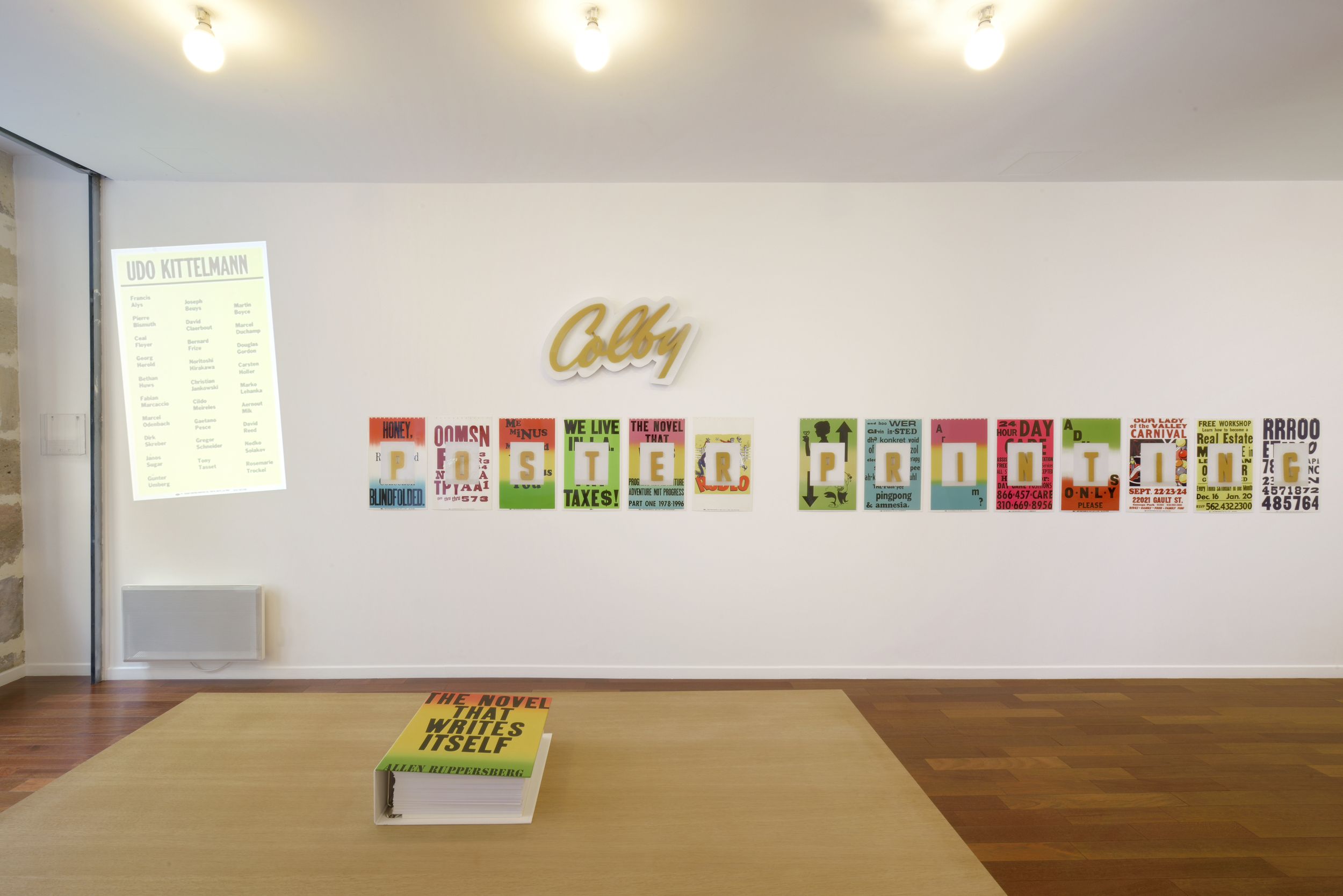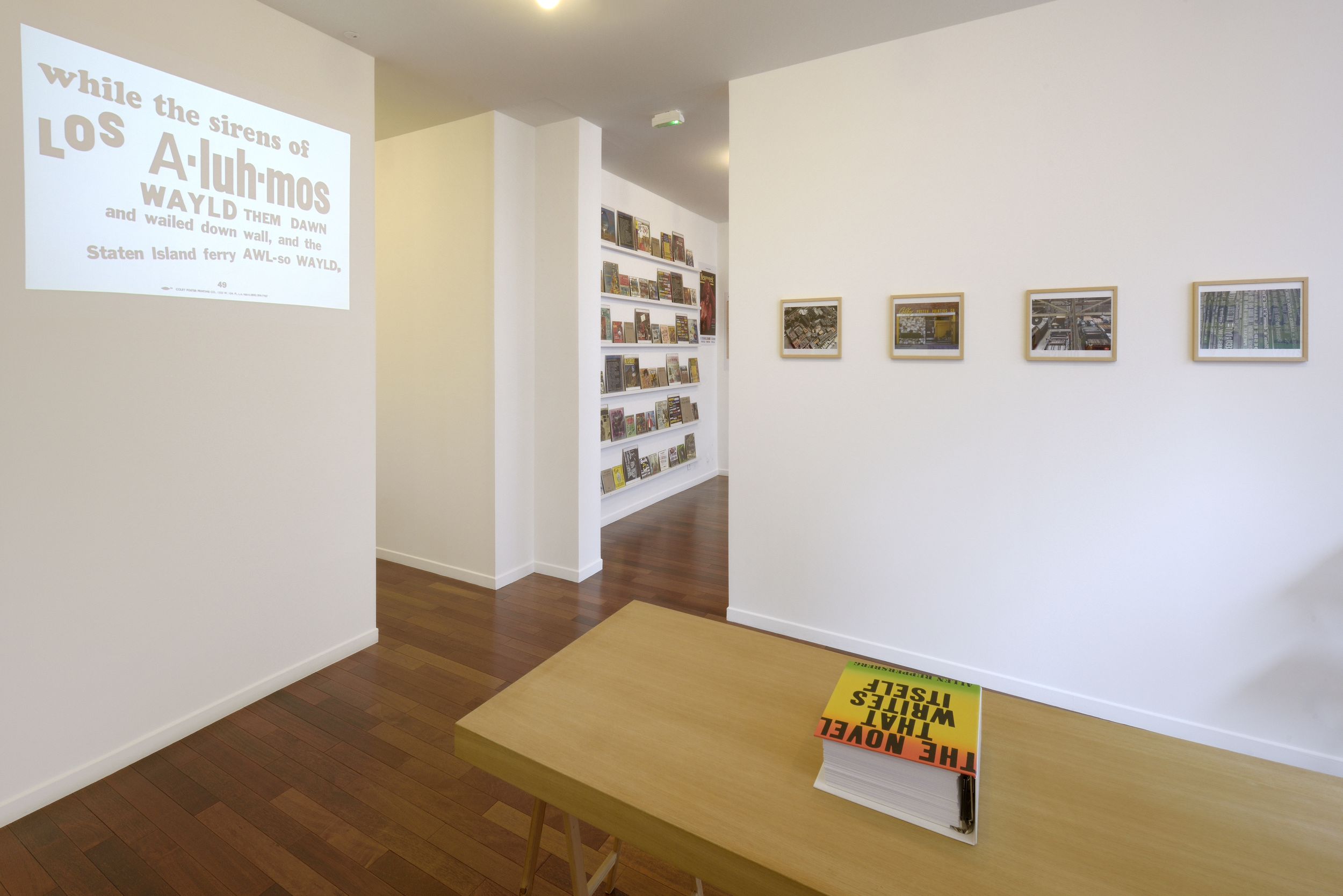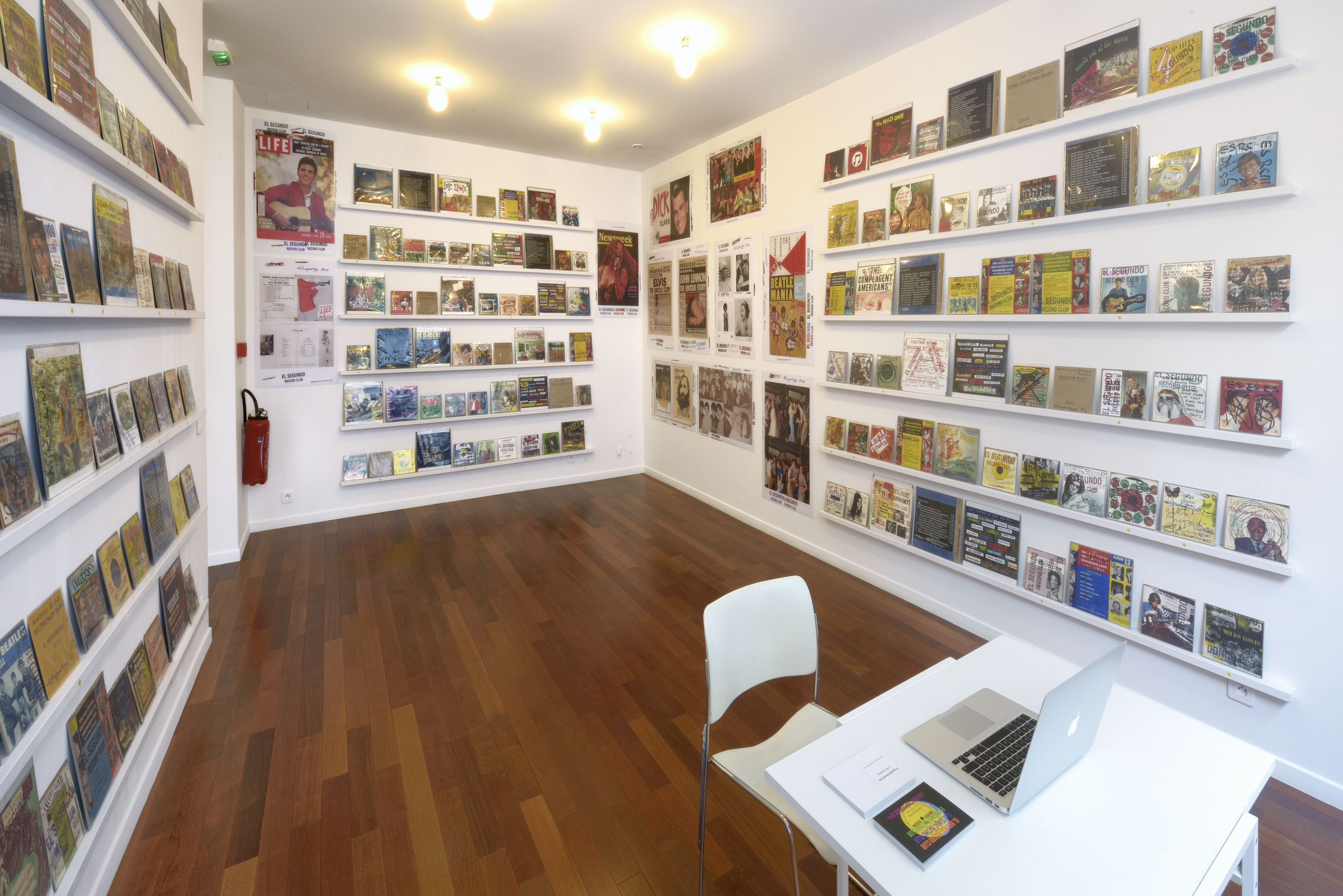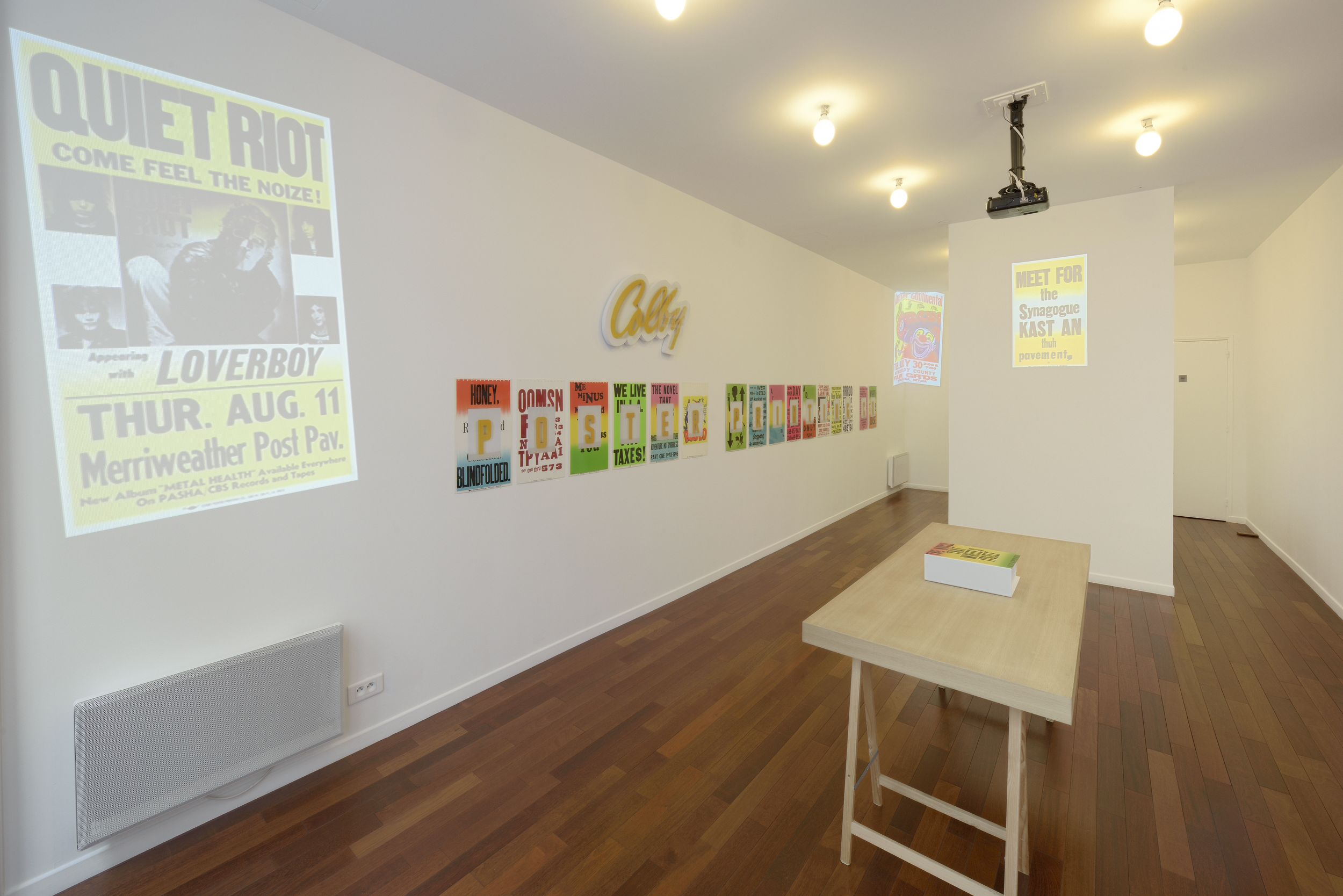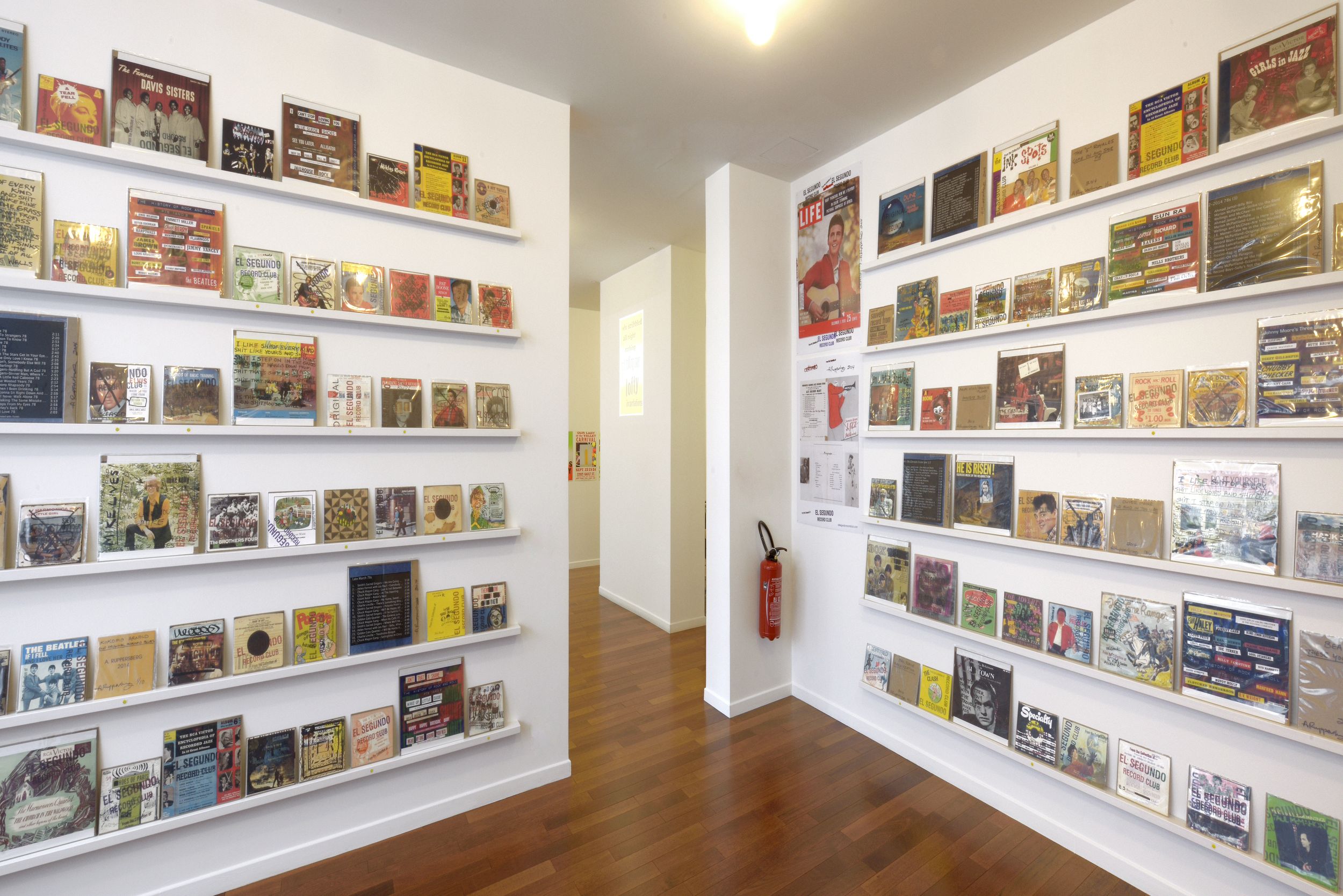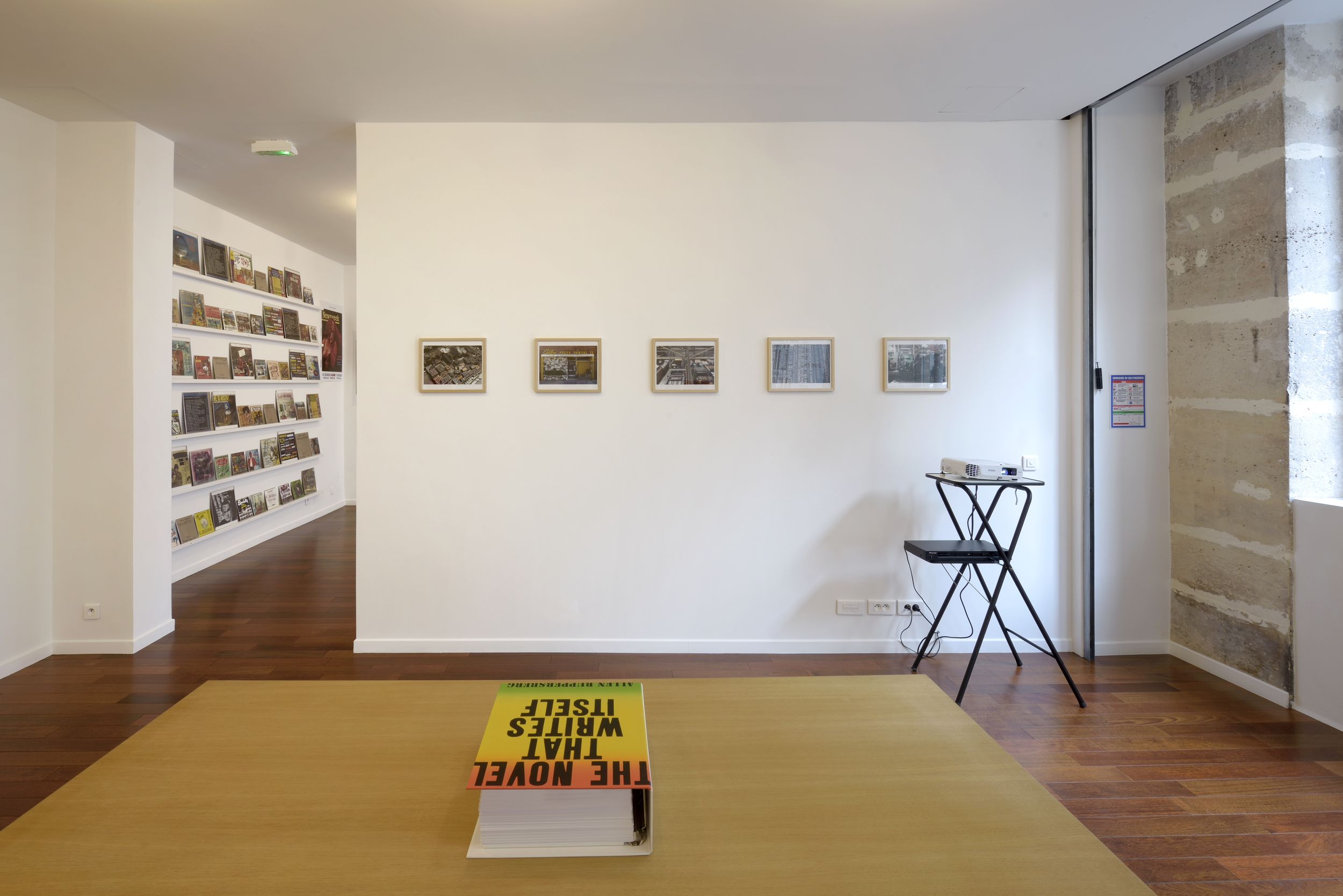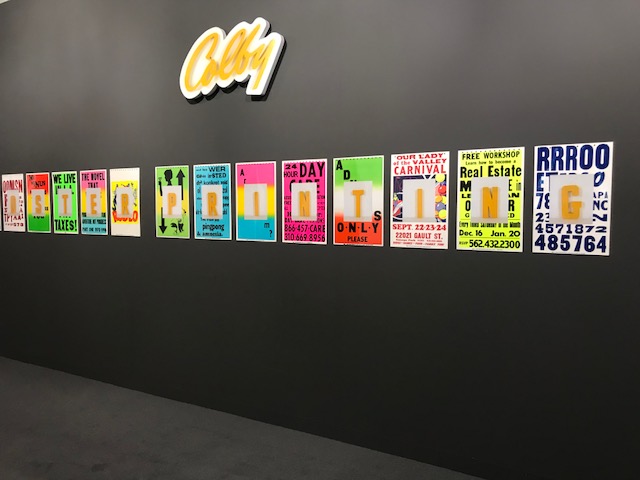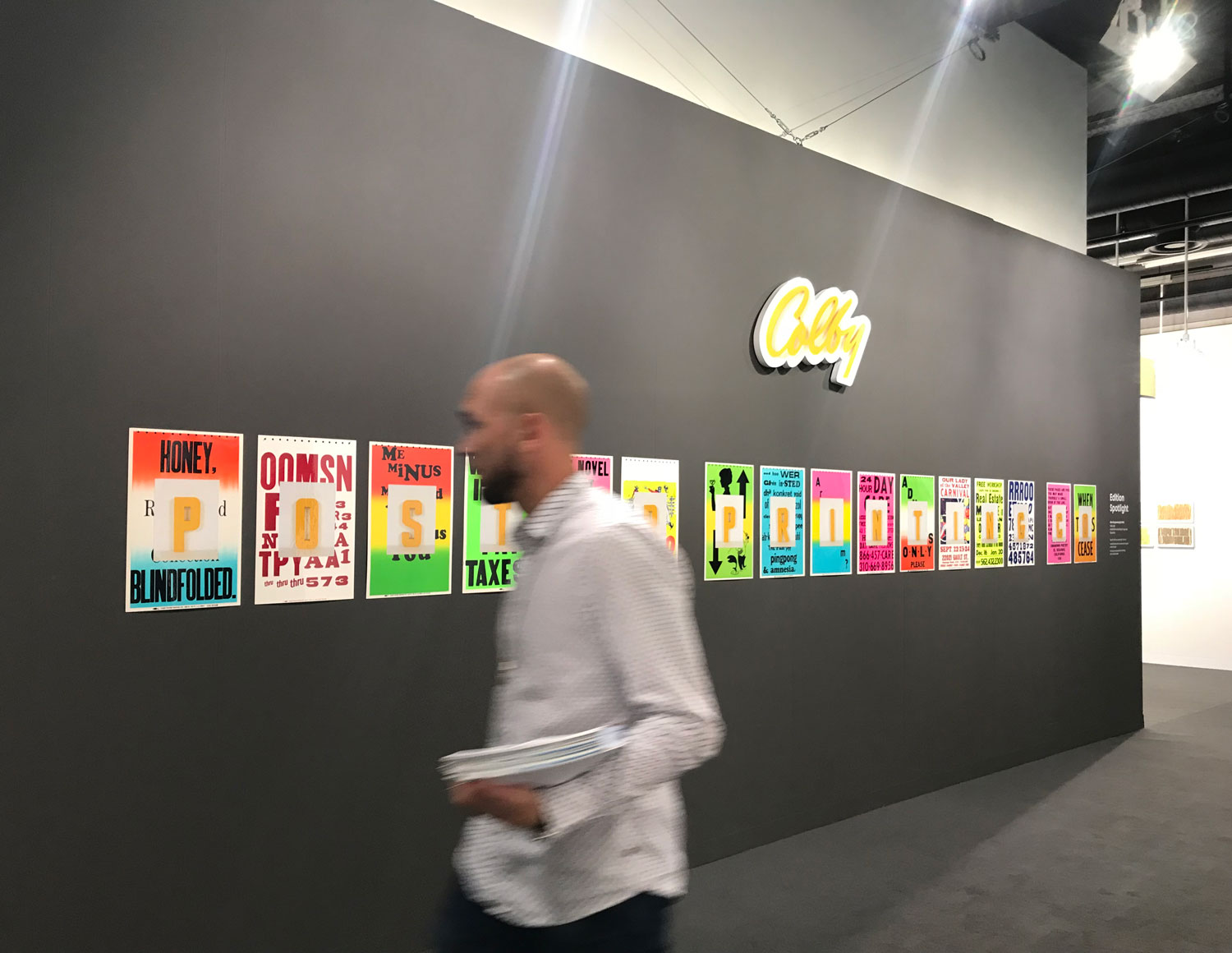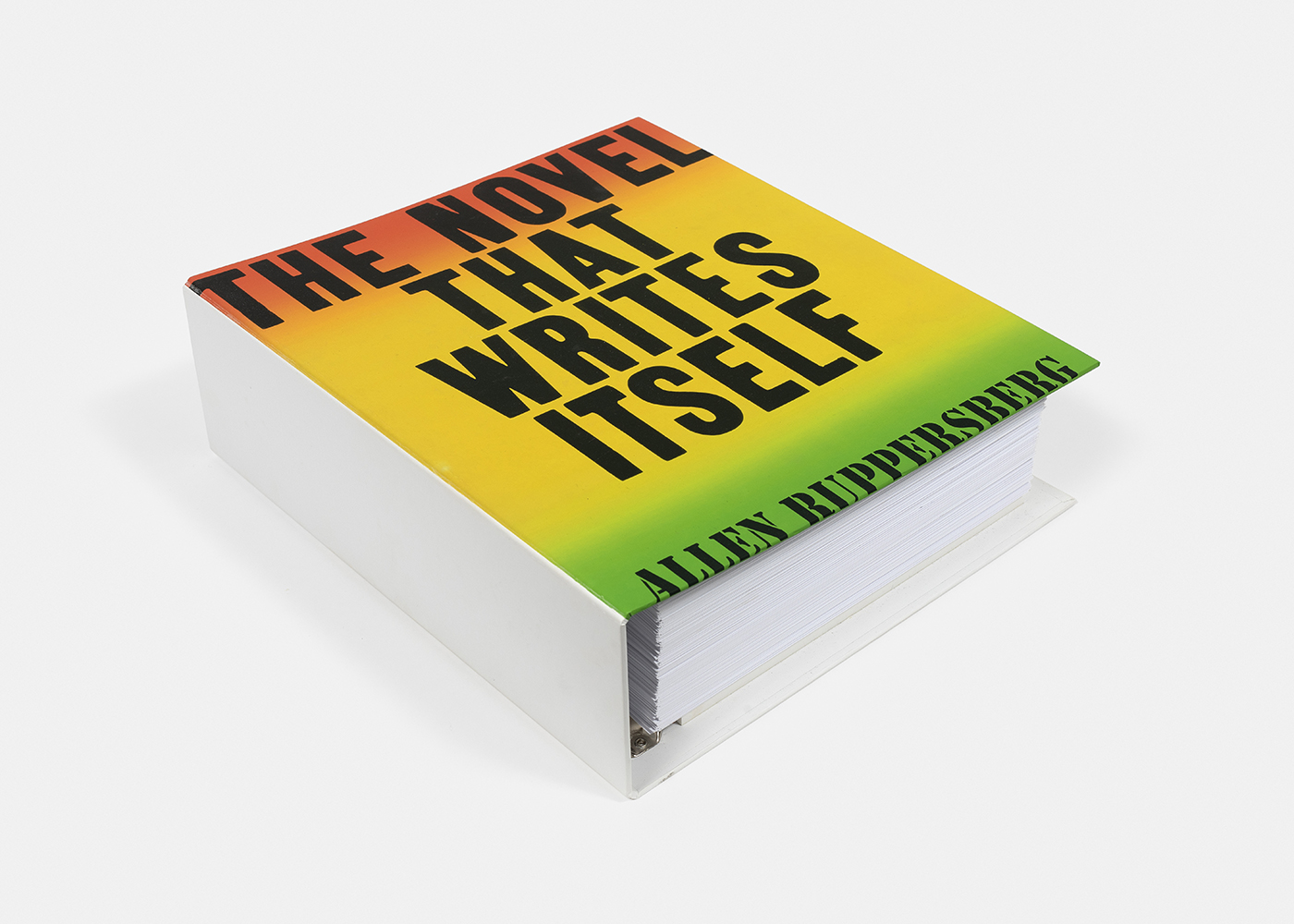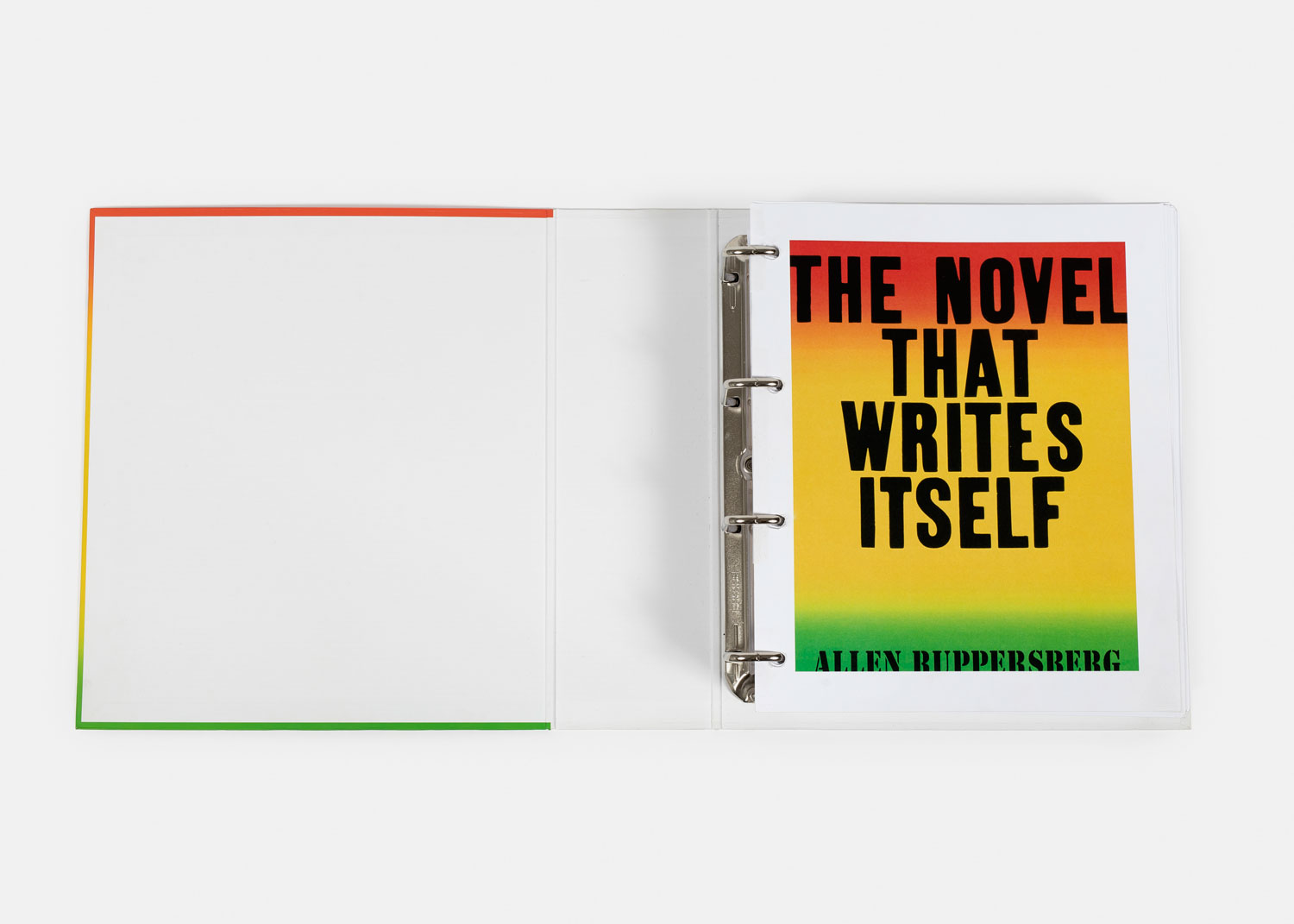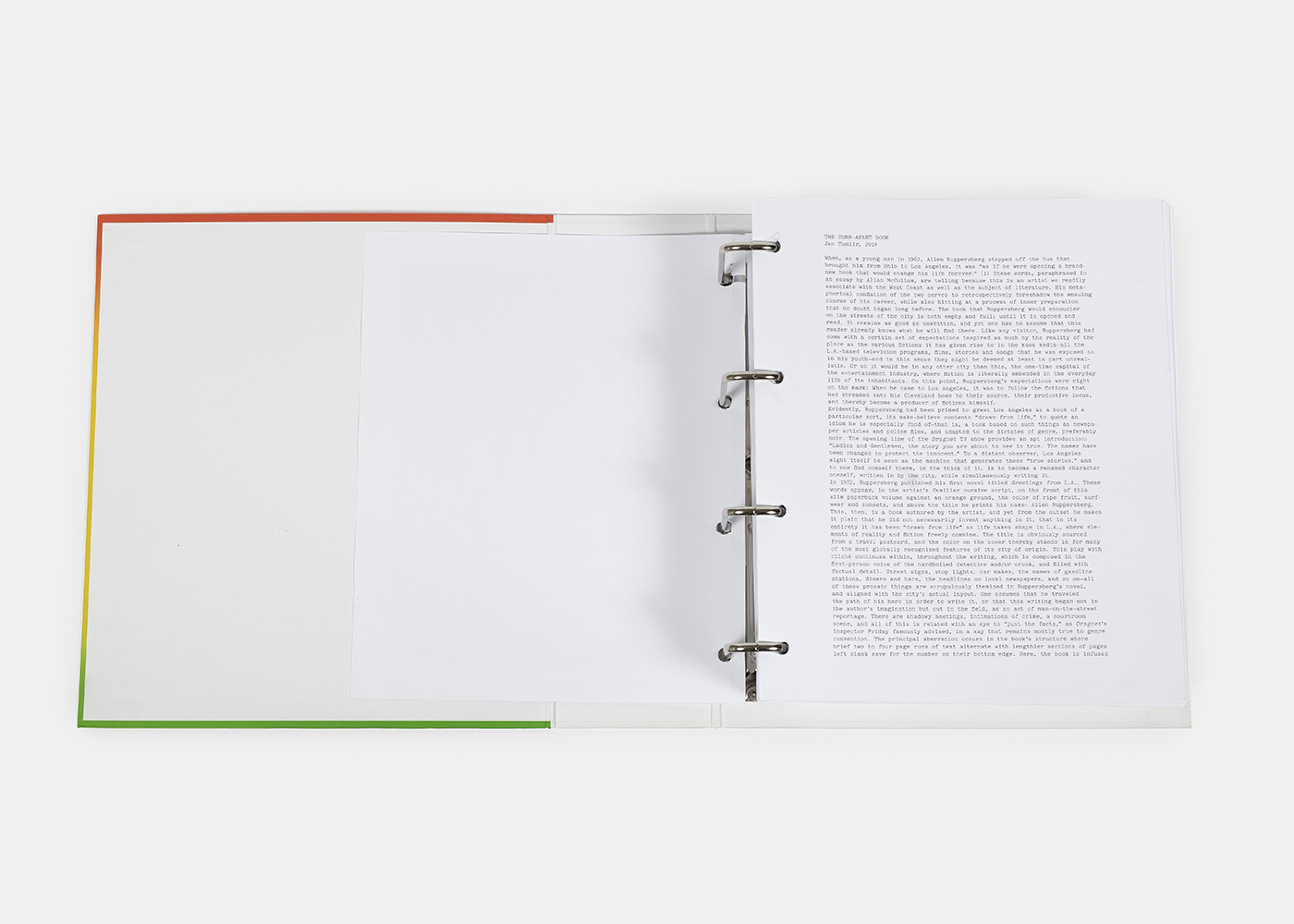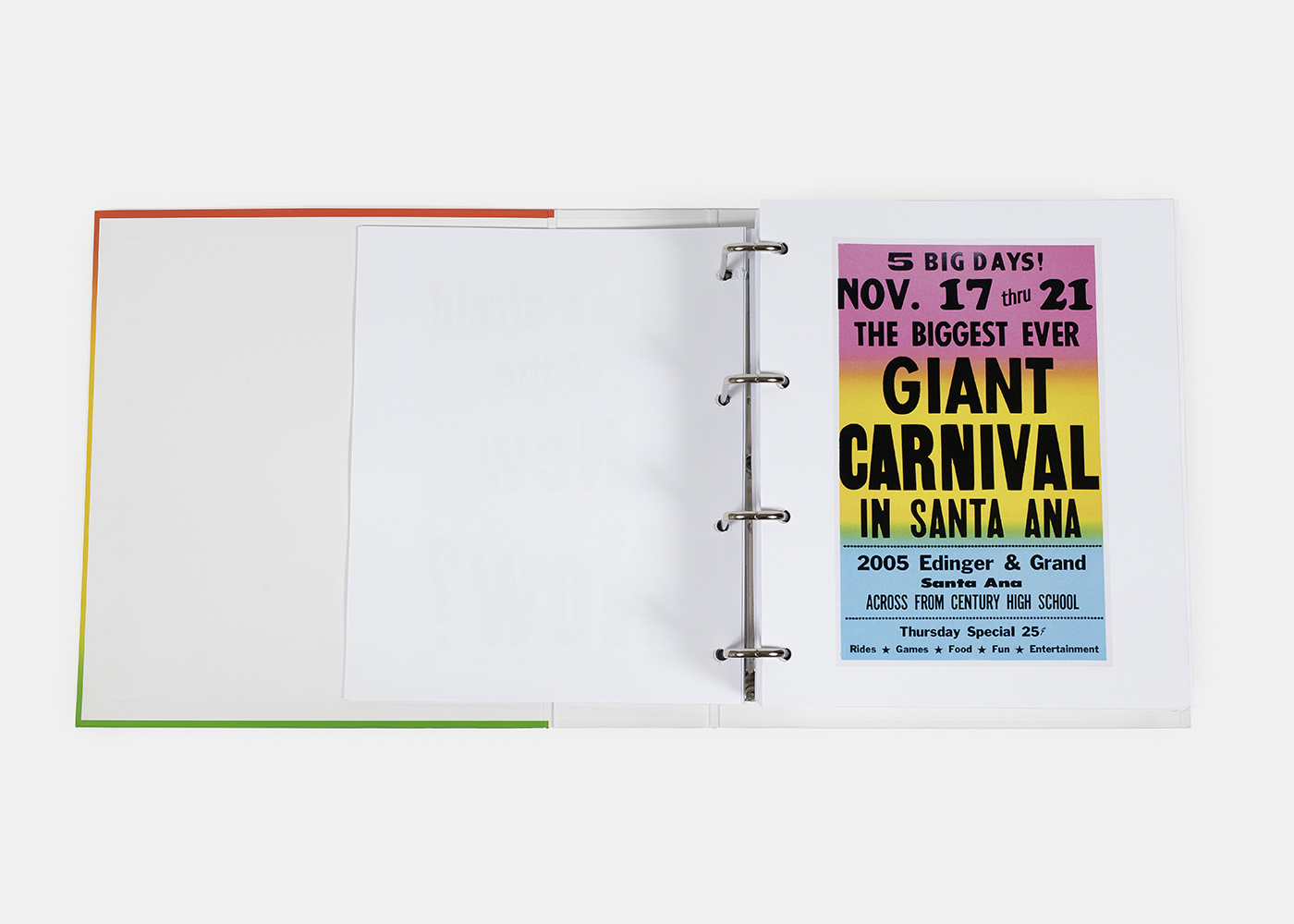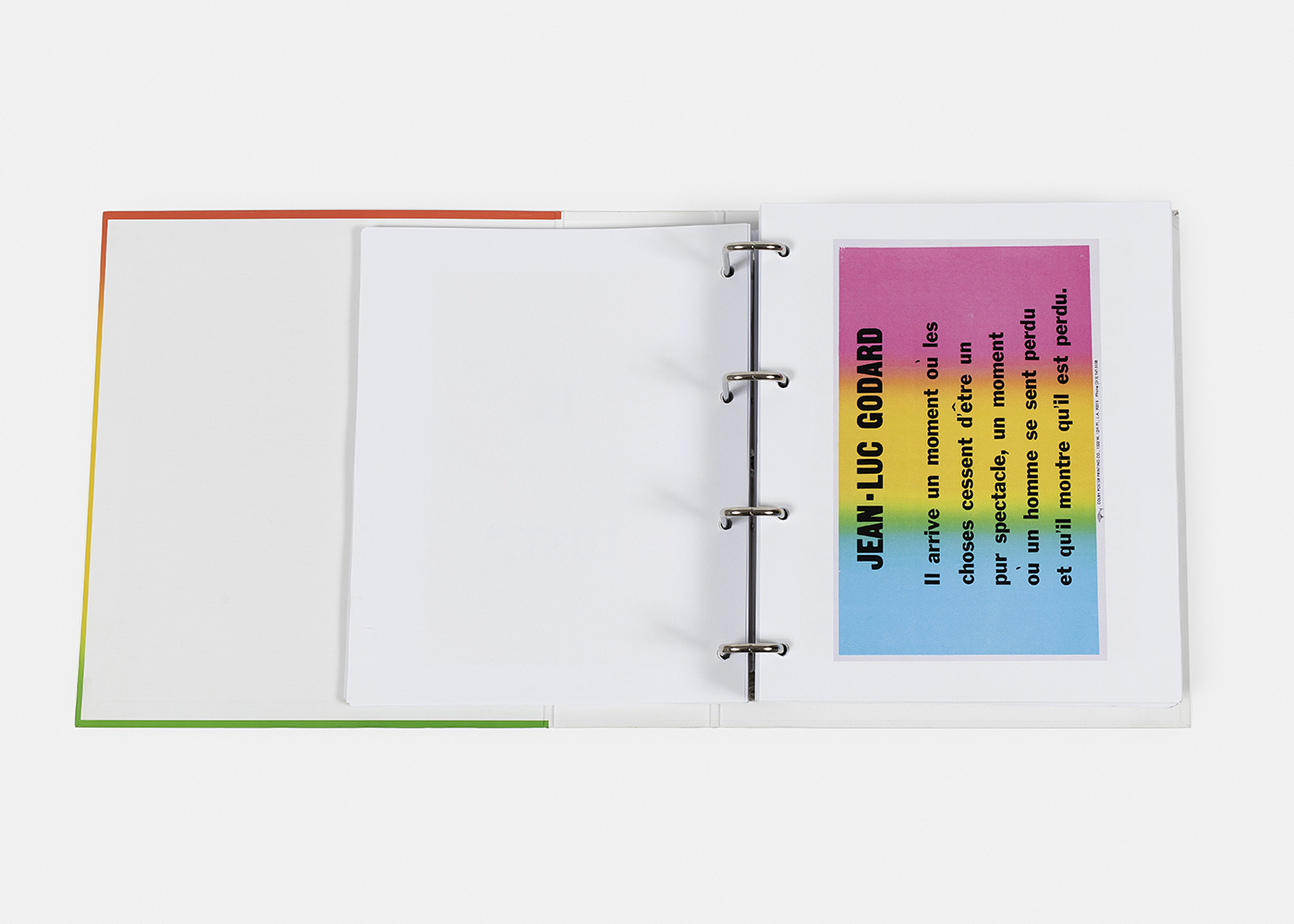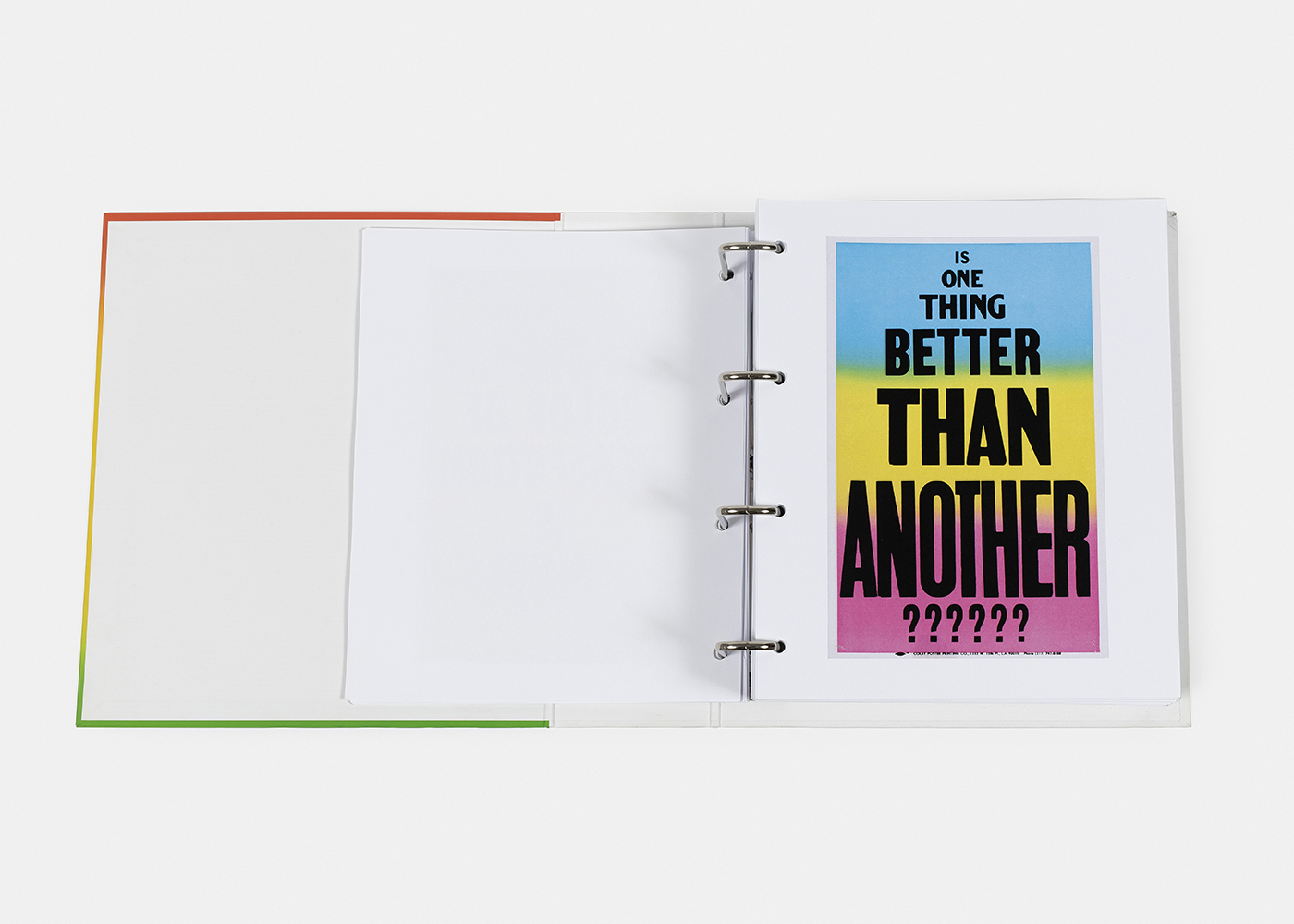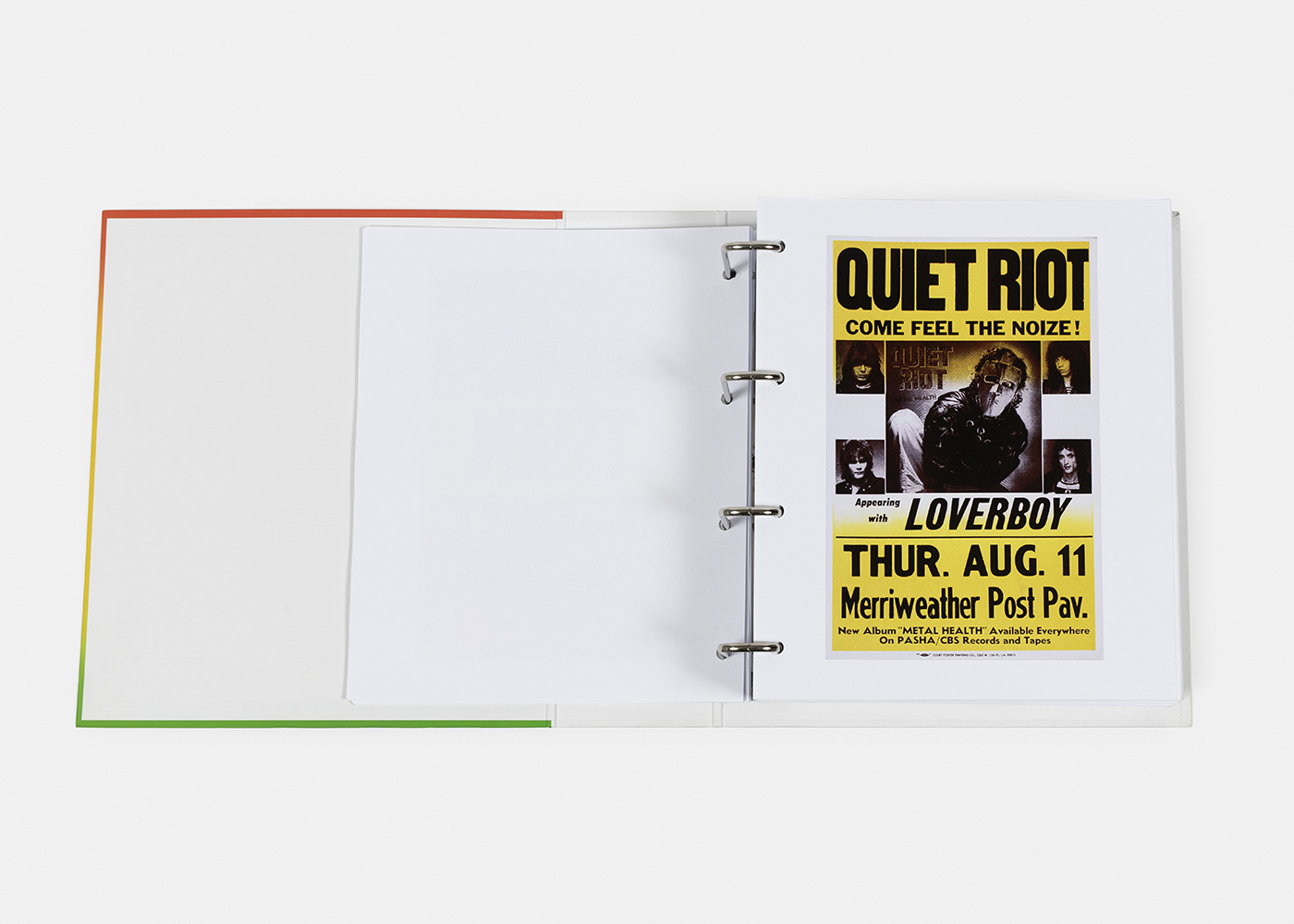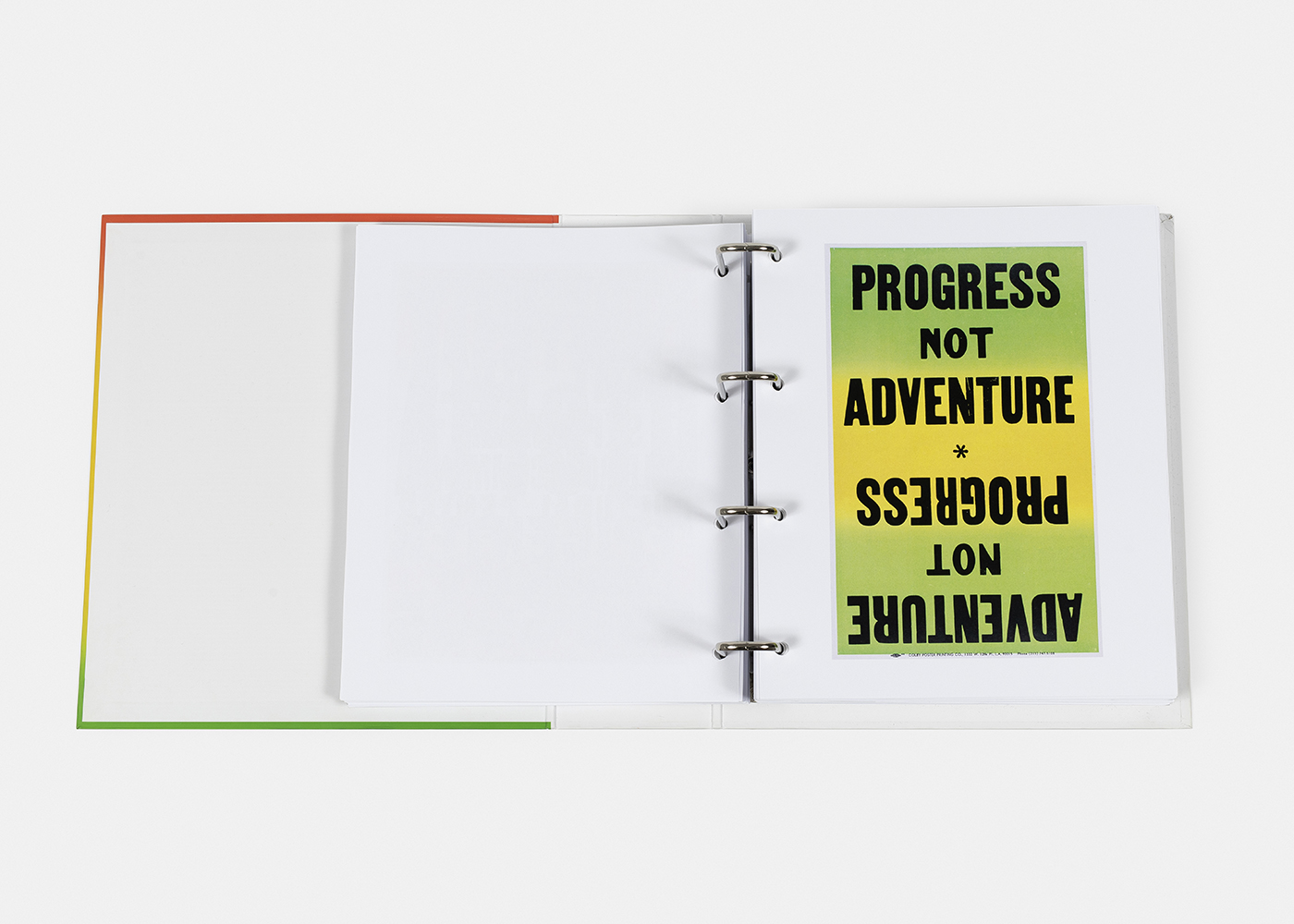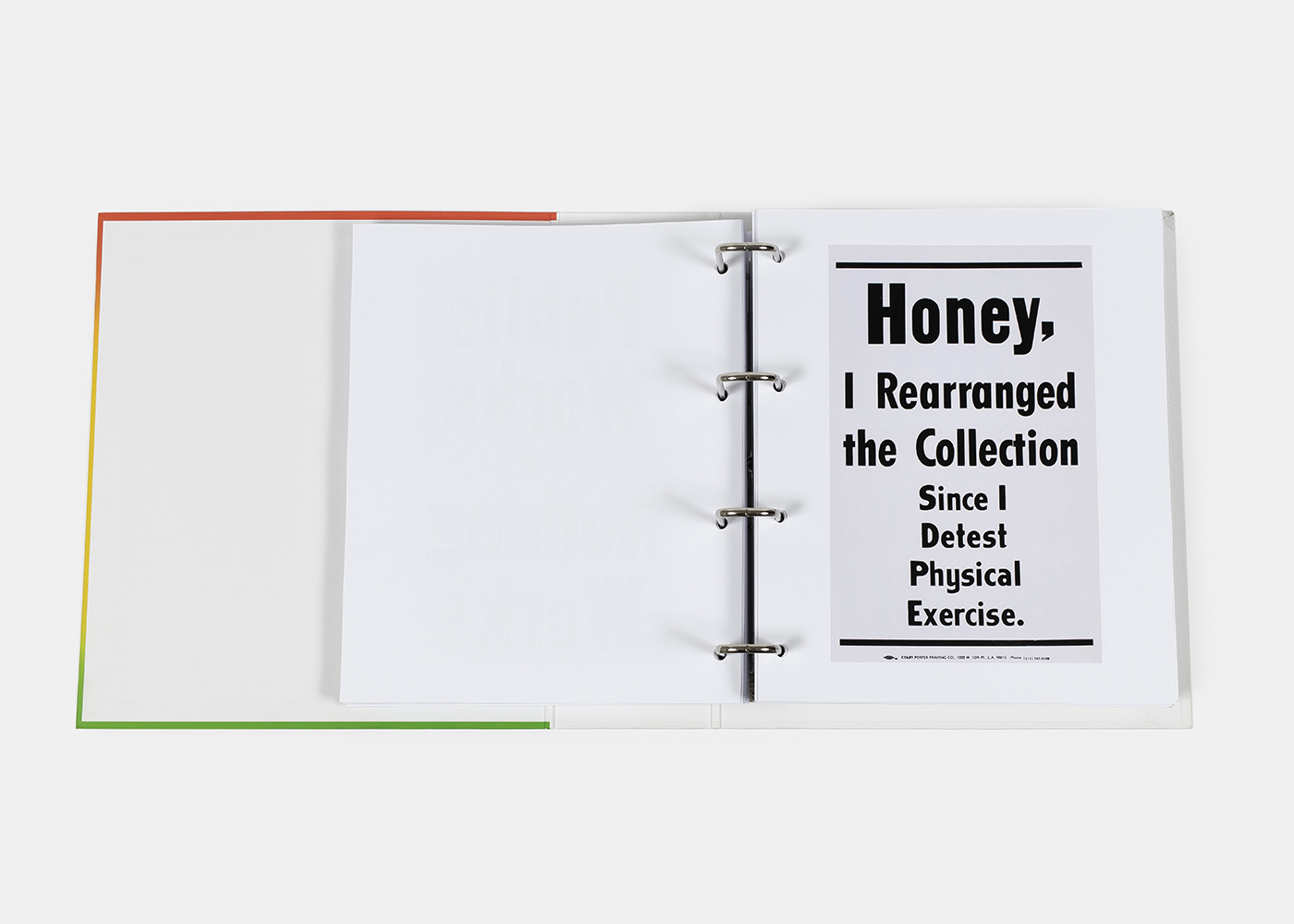Allen Ruppersberg - The Novel that Writes Itself - Exhibitionmfc-michèle didier | Paris - Brussels - PARIS
Exhibition from September 12 to October 31, 2014
Opening on September 11, 2014 from 6pm to 9pm
The Novel That Writes Itself
It all begins with the end of a story, the one about the Colby Poster Printing Company that shut down in December 2012, taking with itself an emblematical graphic identity into history. A Colby poster can be easily distinguished from others and bear the stamp «from L.A.». Multicolored posters with unexpected gradients of flashy, typically Californian colors - the yellow of the sun or the beach, the green of the lush vegetation in this "West Coast" Eden, the blue of the ocean, the red or the pink of all the other wonders of this heavenly place on earth - the Colby posters, covered with outrageously bold characters, do not respect any typographical rules. These rules are mistreated, possibly by ignorance, probably on purpose; in either case it is a certain rule of the West not to follow the rules of the East.
«Colby Posters were the ultimate graphic design "ready-mades" and I think Marcel Duchamp would agree.»1 says Julia Luke of the Hammer Museum.
Individuals or professionals of Los Angeles entrusted the production of their communication media to the Colby printing house: announcements for school fairs, concert, political meetings, posters for films, performances or all other services. The posters were then put up on the wooden utility poles that characterized the city, as true marks of identity in the cityscape of Los Angeles. Many other artists and celebrities, such as Elvis Presly, Martin Luther King, Ed Ruscha or Eve Fowler also turned to this particular aesthetic. Allen Ruppersberg was one of their most faithful and regular customers.
From the book to the posters, from the posters to the binder
It begins also in 1978, when Allen Ruppersberg has an idea of a work in progress which he would call The Novel That Writes Itself, and which he would make in the shape of a fictionalized autobiography where he would talk of his adventures as a young artist, which he is at the time. The main characters by his side in this novel would be the artist's friends (Ed Ruscha), his gallery owner (Rosamund Felsen), collectors (Elyse and Stanley Grinstein) who would buy their places in the story for 300 dollars. Allen Ruppersberg also provides the opportunity to become a supporting character for 100 dollars or to be an extra for 50 dollars. A decade later, Allen Ruppersberg does not manage to materialize the project, he is still missing some elements.
In parallel to this project, he starts to produce aphorisms or enigmatic questions - THERE IS JUST / A MOMENT / WHEN THINGS CEASE, HOW I MISS THE AVANT-GARDE - printed on multicolored posters. These posters, the famous Colbys, start to show up at his exhibitions around the middle of the 1980s. He realizes in 1990 that in fact "the novel had written itself" without his knowing. By then, 50 posters had been produced. The Novel That Writes Itself is thus given substance to by Colby Posters through which he shows not only how the characters of his autobiography evolve but also an array of his projects such as Honey, I rearranged the collection or The Singing Posters, a phonetic interpretation of Howl, a poem by Allen Ginsberg.
The pages of The Novel That Writes Itself, a work whose essentially romanesque nature requires the shape of a book, break away one by one to be put on the walls of galleries or museums. This novel by Allen Ruppersberg takes, in its provisional form, the shape of a renewed installation, enriched with each new presentation. In the footsteps Allen Ruppersberg declines the traditional structure of a book by turning its pages into posters. Jan Tumlir quotes, in his introductory text to The Novel That Writes Itself, the following words by El Lissitzky: «The traditional book was torn into separate pages, enlarged a hundredfold, colored for greater intensity, and brought into the street...»2 The artist lives a different life from the renown typographer but their intentions converge.
The Novel That Writes Itself finishes to write itself in 2013 with the closing of the Colby Company. Time has come, perhaps, to bring back the classic format of a novel. Allen Ruppersberg, however, has chosen to compensate the constraint of a book by giving it the independence of a poster. The binder holds together a number of separate pages who can keep their original poster-like nature.
The Novel That Writes Itself builds itself in the way a cadavre exquis is made, through a random mixing of posters from the Colby printing house that the artist has collected, some pictures of installations of The Novel That Writes Itselfand, Allen Ruppersberg's very own Colby Posters. He thinks of the artist?s book as an interactive sculpture, in a similar way to how he had perceived his first novel Greetings from L.A. in 1972. The Novel That Writes Itself took him more time (1978 - 2014) but the writing of this piece required by its nature the experiences Allen Ruppersberg went through in his life as an artist which, in his case, are as numerous and varied as the posters themselves.
1 Julia Luke, Senior Designer Hammer Museum, in Printing the Identity of Los Angeles, text by Chad Kouri, 2013, http://www.mascontext.com/
2 Jan Tumlir, The Torn-Apart Book, text published in The Novel That Writes Itself, 2014
The exhibition at mfc-michèle didier gallery
The exhibition will consist of two different parts: The Novel That Writes Itself and EL SEGUNDO RECORD CLUB
The Novel That Writes Itself is a new edition by Allen Ruppersberg, the fourth production of the artist published by mfc-michèle didier. Prior to this work have been produced the installation The New Five Foot Shelf in 2001, the artist book The New Five Foot Shelf of Books in 2003 and Chapter VI in 2009.
The Novel That Writes Itself is a finished whole of a novel in progress, initiated in 1978 by the artist. This work includes, gathered in a binder of more than 10 cm thick, the text The Torn- Apart Book by Jan Tumlir, in introduction, and a series of 460 single-sided perforated sheets. Page after page, we discover the posters produced by the artist at the Colby Poster Printing Company up until its closing down in 2013, the posters Colby had produced that the artist had collected, and several photographs of past installations of The Novel That Writes Itself which come to punctuate the narration. The exhibition, by offering the possibility to handle the binder, a heavy object, will give each person the chance to feel the magnitude of the novel-artwork The Novel That Writes Itself. The work is meant to be Allen Ruppersberg?s autobiography, as fictionalized as it may be, and must therefore embrace the essence of the artist's work during the past 40 years.
The opening night of the exhibition will also provide the occasion for a whole new record store imagined by Allen Ruppersberg to open its doors : EL SEGUNDO RECORD CLUB.
EL SEGUNDO RECORD CLUB follows the mythical tradition of the 1969 Al?s cafe and the 1971 Al?s Grand Hotel, two projects by Allen Ruppersberg which consisted respectively of opening a fully-functionning café and hotel, the originality coming from the fact that they were run according to rules defined by the artist. These places became, in a matter of a few weeks, places of assembly, parties or performances.
EL SEGUNDO RECORD CLUB is run according to other principles imagined by Allen Ruppersberg, in line with the nature of this new setting, a vinyl and poster store to be explored.
The artist has imagined El Segundo Record Club in accordance to a precise protocol. He has digitalized a part of his personal record collection - records from the 1920' to the year 1995 - which he copied on blank vintage discs, using an old disc recorder. Each title selected by Allen Ruppersberg is recorded on several discs, forming series - consisting of 10 and 20 copies. Each one of these records has been slipped into a unique sleeve - different from the title, - that was customized by the artist using another vintage record sleeve. Each one is signed, dated and shows the label "El Segundo Record Club". Each record is thus unique.
According to the artist's wish, the records and the posters may only be purchased through the website that was especially set up for the project: www.elsegundorecordclub.com
A computer has been made available in the exhibition space in order for the visitor to place an order on site, but the purchase can be made anywhere, at any time.
Only the El Segundo Record Club poster / sign is for sale directly at the gallery. It consists of a limited edition of 10 copies, of which each poster is different in color and composition.
Exhibition from September 12 to October 31, 2014
Opening on September 11, 2014 from 6pm to 9pm
The Novel That Writes Itself
It all begins with the end of a story, the one about the Colby Poster Printing Company that shut down in December 2012, taking with itself an emblematical graphic identity into history. A Colby poster can be easily distinguished from others and bear the stamp «from L.A.». Multicolored posters with unexpected gradients of flashy, typically Californian colors - the yellow of the sun or the beach, the green of the lush vegetation in this "West Coast" Eden, the blue of the ocean, the red or the pink of all the other wonders of this heavenly place on earth - the Colby posters, covered with outrageously bold characters, do not respect any typographical rules. These rules are mistreated, possibly by ignorance, probably on purpose; in either case it is a certain rule of the West not to follow the rules of the East.
«Colby Posters were the ultimate graphic design "ready-mades" and I think Marcel Duchamp would agree.»1 says Julia Luke of the Hammer Museum.
Individuals or professionals of Los Angeles entrusted the production of their communication media to the Colby printing house: announcements for school fairs, concert, political meetings, posters for films, performances or all other services. The posters were then put up on the wooden utility poles that characterized the city, as true marks of identity in the cityscape of Los Angeles. Many other artists and celebrities, such as Elvis Presly, Martin Luther King, Ed Ruscha or Eve Fowler also turned to this particular aesthetic. Allen Ruppersberg was one of their most faithful and regular customers.
From the book to the posters, from the posters to the binder
It begins also in 1978, when Allen Ruppersberg has an idea of a work in progress which he would call The Novel That Writes Itself, and which he would make in the shape of a fictionalized autobiography where he would talk of his adventures as a young artist, which he is at the time. The main characters by his side in this novel would be the artist's friends (Ed Ruscha), his gallery owner (Rosamund Felsen), collectors (Elyse and Stanley Grinstein) who would buy their places in the story for 300 dollars. Allen Ruppersberg also provides the opportunity to become a supporting character for 100 dollars or to be an extra for 50 dollars. A decade later, Allen Ruppersberg does not manage to materialize the project, he is still missing some elements.
In parallel to this project, he starts to produce aphorisms or enigmatic questions - THERE IS JUST / A MOMENT / WHEN THINGS CEASE, HOW I MISS THE AVANT-GARDE - printed on multicolored posters. These posters, the famous Colbys, start to show up at his exhibitions around the middle of the 1980s. He realizes in 1990 that in fact "the novel had written itself" without his knowing. By then, 50 posters had been produced. The Novel That Writes Itself is thus given substance to by Colby Posters through which he shows not only how the characters of his autobiography evolve but also an array of his projects such as Honey, I rearranged the collection or The Singing Posters, a phonetic interpretation of Howl, a poem by Allen Ginsberg.
The pages of The Novel That Writes Itself, a work whose essentially romanesque nature requires the shape of a book, break away one by one to be put on the walls of galleries or museums. This novel by Allen Ruppersberg takes, in its provisional form, the shape of a renewed installation, enriched with each new presentation. In the footsteps Allen Ruppersberg declines the traditional structure of a book by turning its pages into posters. Jan Tumlir quotes, in his introductory text to The Novel That Writes Itself, the following words by El Lissitzky: «The traditional book was torn into separate pages, enlarged a hundredfold, colored for greater intensity, and brought into the street...»2 The artist lives a different life from the renown typographer but their intentions converge.
The Novel That Writes Itself finishes to write itself in 2013 with the closing of the Colby Company. Time has come, perhaps, to bring back the classic format of a novel. Allen Ruppersberg, however, has chosen to compensate the constraint of a book by giving it the independence of a poster. The binder holds together a number of separate pages who can keep their original poster-like nature.
The Novel That Writes Itself builds itself in the way a cadavre exquis is made, through a random mixing of posters from the Colby printing house that the artist has collected, some pictures of installations of The Novel That Writes Itselfand, Allen Ruppersberg's very own Colby Posters. He thinks of the artist?s book as an interactive sculpture, in a similar way to how he had perceived his first novel Greetings from L.A. in 1972. The Novel That Writes Itself took him more time (1978 - 2014) but the writing of this piece required by its nature the experiences Allen Ruppersberg went through in his life as an artist which, in his case, are as numerous and varied as the posters themselves.
1 Julia Luke, Senior Designer Hammer Museum, in Printing the Identity of Los Angeles, text by Chad Kouri, 2013, http://www.mascontext.com/
2 Jan Tumlir, The Torn-Apart Book, text published in The Novel That Writes Itself, 2014
The exhibition at mfc-michèle didier gallery
The exhibition will consist of two different parts: The Novel That Writes Itself and EL SEGUNDO RECORD CLUB
The Novel That Writes Itself is a new edition by Allen Ruppersberg, the fourth production of the artist published by mfc-michèle didier. Prior to this work have been produced the installation The New Five Foot Shelf in 2001, the artist book The New Five Foot Shelf of Books in 2003 and Chapter VI in 2009.
The Novel That Writes Itself is a finished whole of a novel in progress, initiated in 1978 by the artist. This work includes, gathered in a binder of more than 10 cm thick, the text The Torn- Apart Book by Jan Tumlir, in introduction, and a series of 460 single-sided perforated sheets. Page after page, we discover the posters produced by the artist at the Colby Poster Printing Company up until its closing down in 2013, the posters Colby had produced that the artist had collected, and several photographs of past installations of The Novel That Writes Itself which come to punctuate the narration. The exhibition, by offering the possibility to handle the binder, a heavy object, will give each person the chance to feel the magnitude of the novel-artwork The Novel That Writes Itself. The work is meant to be Allen Ruppersberg?s autobiography, as fictionalized as it may be, and must therefore embrace the essence of the artist's work during the past 40 years.
The opening night of the exhibition will also provide the occasion for a whole new record store imagined by Allen Ruppersberg to open its doors : EL SEGUNDO RECORD CLUB.
EL SEGUNDO RECORD CLUB follows the mythical tradition of the 1969 Al?s cafe and the 1971 Al?s Grand Hotel, two projects by Allen Ruppersberg which consisted respectively of opening a fully-functionning café and hotel, the originality coming from the fact that they were run according to rules defined by the artist. These places became, in a matter of a few weeks, places of assembly, parties or performances.
EL SEGUNDO RECORD CLUB is run according to other principles imagined by Allen Ruppersberg, in line with the nature of this new setting, a vinyl and poster store to be explored.
The artist has imagined El Segundo Record Club in accordance to a precise protocol. He has digitalized a part of his personal record collection - records from the 1920' to the year 1995 - which he copied on blank vintage discs, using an old disc recorder. Each title selected by Allen Ruppersberg is recorded on several discs, forming series - consisting of 10 and 20 copies. Each one of these records has been slipped into a unique sleeve - different from the title, - that was customized by the artist using another vintage record sleeve. Each one is signed, dated and shows the label "El Segundo Record Club". Each record is thus unique.
According to the artist's wish, the records and the posters may only be purchased through the website that was especially set up for the project: www.elsegundorecordclub.com
A computer has been made available in the exhibition space in order for the visitor to place an order on site, but the purchase can be made anywhere, at any time.
Only the El Segundo Record Club poster / sign is for sale directly at the gallery. It consists of a limited edition of 10 copies, of which each poster is different in color and composition.
Exposed artworks
Installation, includes an original Colby® sign and 16 laminated posters.
Sign 21.65 x 35.43 in, each poster 22.05 x 13.78 in
Binder, 468 pages
12.99 x 11.81 x 4.33 in ( 33 x 30 x 11 cm )
